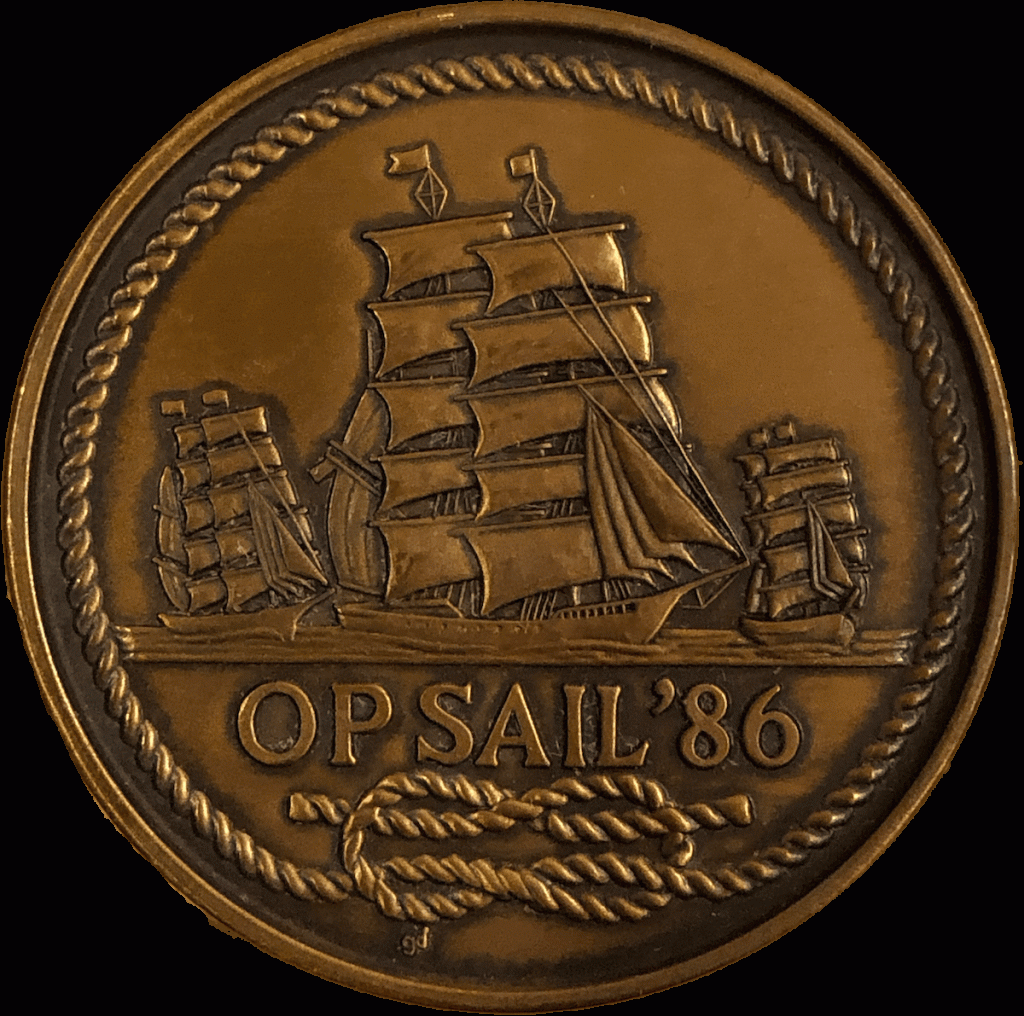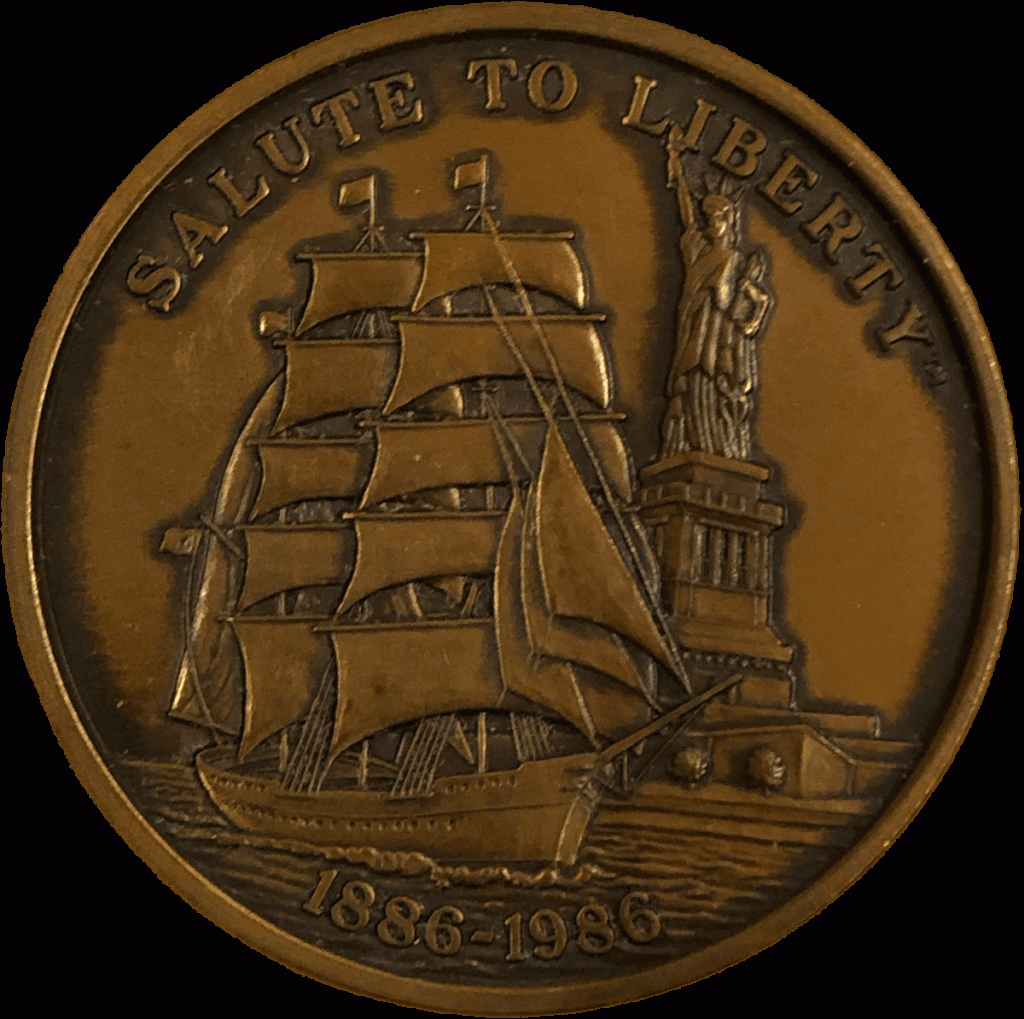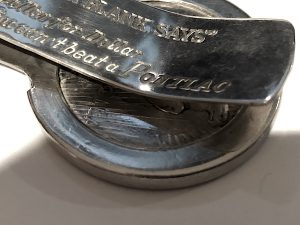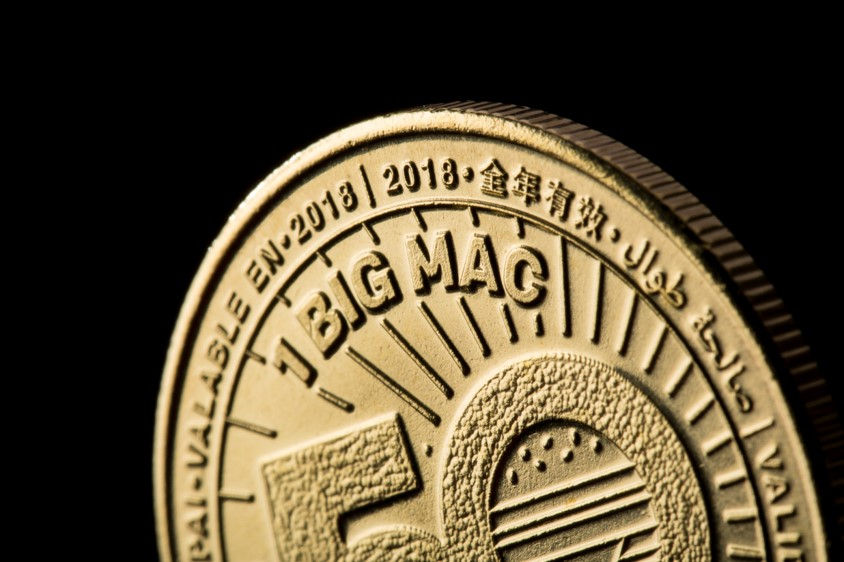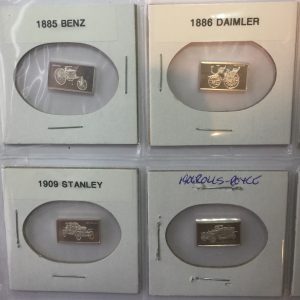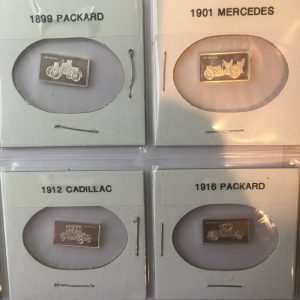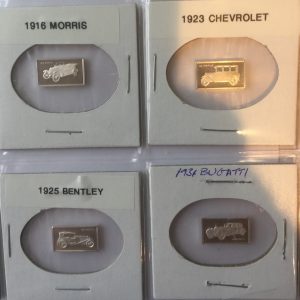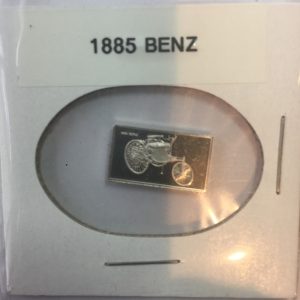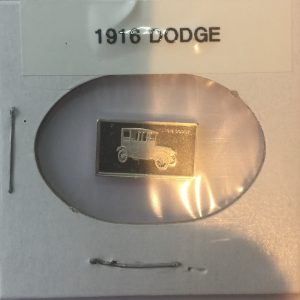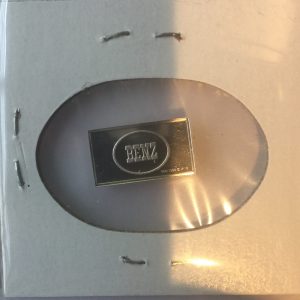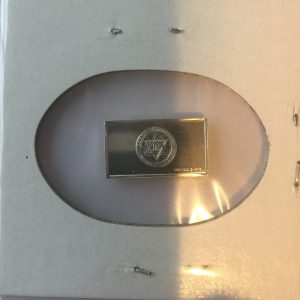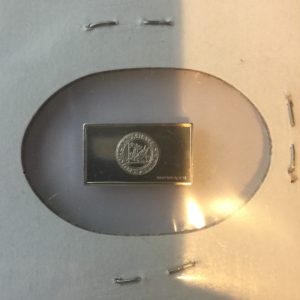Mar 27, 2022 | awards, exonumia, medals, news
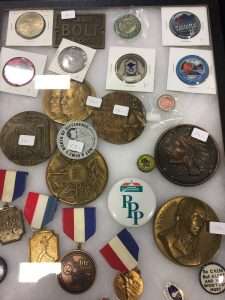
Medals, awards, casino chips, and a Challenge Coin
Medals come in many forms, from those that can be pinned to clothing to something equivalent to a token. They can be shaped, round, or a multilayered object presented to winners, participants, or for significant achievements.
Some people collect medals but may not consider themselves numismatists. Michael Phelps may not consider himself a numismatist but has one heckuva collection of Olympic medals, and Katie Ladecky is building quite a collection.
Challenge coins are a type of award. In its original intent, challenge coins are passed to someone deemed worthy of being honored by the issuer. Collectors take pride in collecting challenge coins like Brian Williams. During a segment of Nightly News, Williams showed off his collection. Over the last 10-15 years, challenge coins expanded beyond military service and civilian agencies. City agencies, law enforcement, and many others now issue challenge coins. It has opened the market to new collectors. Challenge coin collectors do not consider themselves numismatists, but they are as dedicated to collecting challenge coins as a Morgan dollar collector searching for VAMs.
As time progresses, there are new opportunities to collect awards and medals. Collections of medals and awards are now selling in estate sales and auctions. Families do not know what their loved ones collected and are selling below value. It is a tremendous opportunity to join this area of the market.
Awards and medals create an opportunity to expand collections and welcome more collectors to the community.
And now the news…

March 18, 2022
Princeton University Library’s (PUL) Numismatic Collection nearly tripled its Byzantine coin collection when it acquired 11,256 Byzantine coins from the estate of Dr. Chris B. Theodotou on March 8, 2022.

→ Read more at
infodocket.com

March 21, 2022
The United States' first woman to fly into space has lifted off a new mission, this time to orbit the nation in the form of a new circulating coin.

→ Read more at
collectspace.com

March 21, 2022
“Working with our partners Excir, we have introduced world-first technology to the UK capable of recovering precious metals from electronic waste in seconds." The Royal Mint is to have a go at a 21st-century approach to alchemy, turning electronic waste into gold.

→ Read more at
proactiveinvestors.co.uk

March 23, 2022
Fans in Samoa can start their own Justice League Silver Coin collection with 12 officially-licenced DC Comics coins celebrating their most legendary heroes & villains.

→ Read more at
supermanhomepage.com

March 23, 2022
The 2,000-year-old gold piece, perhaps worn by one of the murderers, could sell for $2 million

→ Read more at
smithsonianmag.com

March 26, 2022
The rising price of metals including nickel and copper has led to a unique valuation of the metal contained inside common U.S. coins. What Happened: The price of nickel has soared in 2022.

→ Read more at
benzinga.com
Feb 9, 2022 | exonumia, medals
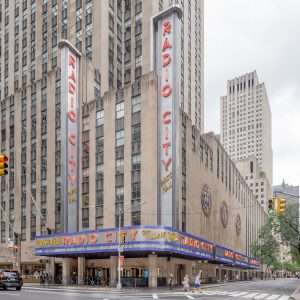
Radio City Music Hall
(Photo by Ajay Suresh used under the CC by 2.0 license)
Radio City, called the Showplace of the Nation, was developed along with Rockefeller Center in 1930-32 for the Metropolitan Opera. The construction of Rockefeller Center was funded by the Rockefeller Foundation, headed by John D. Rockefeller, Jr. When the opera backed out, Rockefeller negotiated with RCA to continue the construction of Radio City as a multimedia showplace.
My first visit to Radio City and Rockefeller Center was in 1968 during the winter break from school. My (late) mother, who grew up on Coney Island, understood that New Yorkers did not take the time to see the sights in their own city. To make up for the time she lost as a child to see New York, she took her children to play tourist during school breaks.
The trip to Manhattan was to see Saint Patrick’s Cathedral, Rockefeller Center, including the ice rink, and then see a movie at Radio City. I do not remember the movie we saw, but my mother later told me that they showed three short movies, and it cost 25-cents for my brother and me (that’s $2 accounting for inflation).
Before going to the movie, we toured the main stage where the famous Rockettes performed. As part of the tour, we saw the Rockettes practice and visited with a few on stage. I remember being amazed at how long their legs were — which is not bad for an eight-year-old!
Many years later, I worked for NBC and visited Radio City often. When NBC was involved in a live production in Radio City, I used my connections within NBC Sports to watch the rehearsals from the production trucks. Before the final rehearsal, I was allowed into Radio City to see the performance. Later, I returned to my office on the 16th floor, two floors above David Letterman’s offices.
The aluminum medal is 40 mm in diameter. On the front is an image of Radio City and the reverse has a view of the main theater looking at the stage. It is a well-executed image that uses the unique design of the theater to give the image depth.
While taking another look at the medal, it reminds me of a Mardi Gras token.
As I keep finding these great collectibles, I have to develop a better way to store them. My current system cannot handle my recent expansion, especially when the tokens and medals are different sizes. I will report what I come up with.
Feb 8, 2022 | exonumia, medals
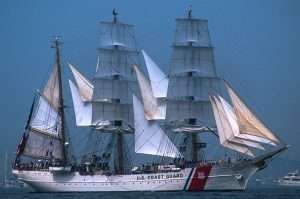
USCGC Eagle from OpSail 2000.
(Image courtesy of OpSail Inc.)
I recently searched the popular online auction site and came across a bronze medal that made me smile. I found a 1986 OpSail commemorative medal.
Operation Sail (OpSail) was founded in 1963 with the support of President John F. Kennedy to celebrate significant milestones in the New York Harbor. OpSail features tall ships of the past but welcomes all sorts of ships from around the world. The first OpSail was the 1964 World’s Fair Parade of Ships. All OpSail events are on July 4th.
The third OpSail was the 1986 Statue of Liberty Centennial, and it was a big year that would become a year-long party for New York City. The Mets started hot and ran away with the National League East, leading to a World Series victory in the fall. The Giants ended their 1985 season in great shape during January. While the Mets were winning the World Series, the Giants were putting their imprint on the NFL, which led to a Super Bowl victory the following January.
In 1986, I lived on Long Island and worked on Wall Street, enjoying life. My parents came to New York for a visit, and we had to go to OpSail. We piled into my car and drove to the Fort Hamilton neighborhood, and we parked and walked to the park area south of the Belt Parkway.
I do not know if the park area along the shore has a name, but we joined the throngs of other people milling around the park to watch the ships sail by. While the parents stayed in one area, the group of cousins walked closer to the Verazzano Bridge to get a better look at the harbor. We had a good view of the water show from the FDNY fireboats. Later, we drove back to Long Island for dinner and took the train into Manhattan to watch the fireworks.
We made our way downtown to the area just north of the entry to the Staten Island Ferry to watch the fireworks. When the fireworks ended, we walked up a few blocks, grabbed some drinks, and let the crowd lighten before taking the train back to Penn Station and back to Long Island.
I dropped my parents off at their hotel before returning to my tiny one-bedroom apartment. The last thing I remember was sitting in a chair drinking water before waking up a few hours later in the same chair.
Finding the medal brought back the flood of memories from that day, and I had to add it to my collection.
While looking for more information about the medal, I came across a 1986 story in The New York Times that described the medals produced for the Statue of Liberty Centennial.
The medal’s obverse is the logo used by OpSail ’86, representing the tall ships surrounded by a rope tied in a square knot. The initials “gd” are along the rim under the left loop of the square knot. The reverse shows a tall ship passing by the Statue of Liberty.
The bronze medal is part of an official three-medal set issued for the celebration. The gold and silver medals contain one troy ounce of the medals. The one-ounce gold medal sold for $595 ($1524 in today’s funds), the one-ounce silver medal sold for $34.95 ($89), and the 51 mm 1.75 ounce bronze medal sold for $19.95 ($50).
The “gd” initials are likely for the Green Duck Mint of Hernando, MS, who struck the medals for OpSail ’86. Maranatha Holdings of Jersey City sold the medals for the organization.
Now that I know there are gold and silver medals for OpSail ’86, I have to find them to complete the set.
The New York Times article said that the Statue of Liberty Foundation issued 11 medals featuring different reverse themes. Frank Gasparro designed the medals. He retired as Chief Engraver of the U.S. Mint in 1981.
I added all 11 medals to my growing wishlist.
Apr 8, 2020 | coins, dollar, exonumia
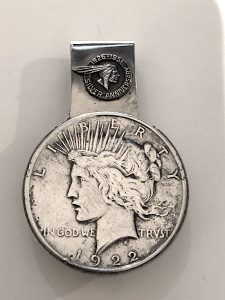 Now that some of us have a little time on our hands, why not think about how you can have fun with your collection. After all, there is more to collecting coins by types or date sets. Sometimes you need to think outside the folder and album and find something different.
Now that some of us have a little time on our hands, why not think about how you can have fun with your collection. After all, there is more to collecting coins by types or date sets. Sometimes you need to think outside the folder and album and find something different.
Take, for example, the money clip pictured here. Embedded in the money clip is a version of my favorite coin, a Peace Dollar. Although the 1922 Peace Dollar may be the most accessible of the series, its presence in this money clip adds to the allure.
But wait, there’s more!
If you look above the Peace Dollar is the Indian Chief emblem of Pontiac, the former automobile division of General Motors. The emblem celebrates the silver anniversary, 25 years, of the Pontiac Motor Division.
 GM introduced Pontiac as a companion marque nameplate to the Oakland Motor Division in 1926. Oakland managed Pontiac to sell cars at a lower price point than other Oakland manufactured vehicles. By 1929, Pontiac became more popular than Oakland, which led to Oakland’s closure in 1931 during the Great Depression.
GM introduced Pontiac as a companion marque nameplate to the Oakland Motor Division in 1926. Oakland managed Pontiac to sell cars at a lower price point than other Oakland manufactured vehicles. By 1929, Pontiac became more popular than Oakland, which led to Oakland’s closure in 1931 during the Great Depression.
Ironically, Pontiac would meet the same fate during the Great Recession. To meet the demands of regulators for accepting a $25 billion federal government loan, GM agreed to close Pontiac and Saturn, sell Saab, and close or sell Hummer as part of the restructuring. Like Oakland, Pontiac is now part of automaking lore.
The 1951 Pontiac Chieftain was a popular car. The Chieftain was available as a sedan, sedan coupe, business coupe, and deluxe convertible coupe. In 1950, Pontiac introduced the Catalina coupe that became a popular option that, in 1959, the Catalina succeeded the Chieftain as a model. The cars sold at the right price point for the burgeoning middle class of the post-war United States.
I drove a 1970 Pontiac Catalina 1977-78. It was big. It was green. It guzzled gas. We nicknamed it, “The Green Bomb.”
Turn over the money clip, and aside from seeing the reverse of the Peace Dollar, the clip is engraved, “Jack Blank Says Dollar for Dollar You can’t Beat a Pontiac.”
Jack Blank Pontiac was located at 1437 Irving Street, NW, in Washington DC. Jack Blank (1901-1980) founded Arcade Pontiac in 1937. In 1951, he renamed the dealership after buying out his partners. Blank retired as company president in 1969.
Blank was a prolific promotor. Aside from buying the rights to be the “Official Car Dealership of the Washington Redskins,” Blank created a lot of promotional items. Numismatically, collectors can find a 1964 encased cent with the dealership’s name and address. The money clip was a one-year promotion.
Blank died in 1980. The last records of the dealership were advertising in 1992 publications.
One collectible satisfies three interests. Numismatically, it is a Peace Dollar. I love the Peace Dollar. Even though this dollar was polished and is glued into an enclosure, it is still a silver dollar.
It is an advertising piece for a vintage car. My two favorite car eras are the muscle cars of the mid-1960s to the early 1970s and the cars of the art deco era. The Chieftain would be redesigned in later years, but it retains the art deco look I like.
Finally, it is part of Washington, DC history that has nothing to do with the government.
It is your turn to go out and find something that will satisfy you numismatically and other interests!
Sep 1, 2019 | commentary, exonumia, news
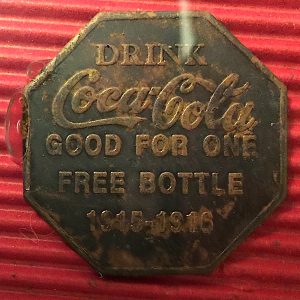
Token for a free bottle of Coca-Cola in 1915-16
Gregory Martin wrote to the editor for KendallCountyNOW.com that he would ” like to bring to mind the concept of starting your young ones on starting a coin collection.”
In three of the four paragraphs, Martin shows his passion for both collecting and how it relates to history. He mentions the 3-cent nickel and the 1943 steel cents as gateways into understanding what was happening in our country’s history.
Martin may have touched on something that today’s teachers can use to explain history. For example, the story of westward expansion was more about economics than exploration. People left the east for better opportunities, to find gold, discover silver, or for 40 acres and a mule. These stories can be taught using the money of the times.
As collectors, we know about fractional currency, postage stamp money, and why arrows periodically appear on minor coinage of the time. However, using these tangible items as props, a teacher can explain the history and show the results by using the money of the time.
Every coin, currency, and token is a reflection of the times when and where produced. A teacher can use the history of the San Francisco Mint to teach about the Gold Rush and the Great Earthquake of 1906.
The New Orleans Mint had its place in the Civil War.
The Carson City Mint is as much a story about the old west as it is about the economic battles, including the Crime of ’73.

One Dollar Baltimore B-Note featuring Frederick Douglas and a Baltimore oriole.
Using numismatics to learn about history goes beyond the United States’ borders. After becoming interested in Canadian coins, I learned more about the British monarchy and the decline of the monarch’s power by studying the transitions from Queen Victoria to Queen Elizabeth II.
After finding three banknotes from the State of Chihuahua, I learned more about the Mexican Revolution after trying to understand why currency for a three-year state existed.
Maybe it is time to take the saying “history in your hand” and turn it into something tangible. After all, a handful of trade and sales tax tokens may have more of an impact than just reading about the Great Depression.
And now the news…

August 18, 2019
A Utah businessman paid $1.32 million for a dime last week at a Chicago coin auction. It wasn't just any 10-cent piece; the 1894-S Barber Dime is one of only 24 that were ever made, according to Stack's Bowers Galleries, which held the auction Thursday night.  → Read more at cnn.com
→ Read more at cnn.com

August 24, 2019
TREASURE-hunters have dug up a hoard of ancient silver coins dating back to the Battle of Hastings in 1066 – worth an impressive £5million. A metal-detecting couple made the lucky find while searching an unploughed field on a farm in north-east Somerset.  → Read more at thesun.co.uk
→ Read more at thesun.co.uk

August 24, 2019
Such a hobby does not take a lot to start and can be rewarding in so many ways. To start with you learn about money and in it's many denominations, including the Civil War 3 cent nickel! In American collecting you can observe the way our country grew and developed, gaining a perspective on people and actions of this great nation.  → Read more at kendallcountynow.com
→ Read more at kendallcountynow.com

August 24, 2019
For the first time in almost half a century the Treasury has ordered the Royal Mint to stop producing any 1p or 2p coins. The crackdown on coppers comes at a time when all our cash is under threat – with banks preferring that we pay for goods online or with cards because it saves them money.  → Read more at thisismoney.co.uk
→ Read more at thisismoney.co.uk
Oct 11, 2018 | currency, education, exonumia, medals, tokens
I was going to stop doing the LOOK BACK series after the summer, thinking I would have time to create new content. But we all know that real life has a way of changing even the best-laid plans. While fighting off a severe sinus infection thanks to the mold spores that thrive in this damp weather, business picked up. I am ecstatic that my new business is catching on but the infection put a damper on things.
I need a week to catch up. While doing so, I will publish two more LOOK BACK articles and try to finish a few of the new posts I started. For today’s LOOK BACK, I want to remind everyone that numismatics is more than coins. You can satisfy your collecting urges with exonumia as well as with coins.
Although the dominant area of numismatics is the collection and study of legal tender coins, numismatics is more than just coins. Numismatic is the collecting and study of items used in the exchange for goods, resolve debts, and objects used to represent something of monetary value. This opens up numismatic collecting to a wide range of items and topics that could make “the hunt” to put together the collection as much fun as having the collection.
Exonumia is the study and collection of tokens, medals, or other coin-like objects that are not considered legal tender. Exonumia opens numismatics to a wide variety of topics that could not be satisfied by collecting coins alone. An example of exonumia is the collection of transportation tokens. You may be familiar with transportation tokens from your local bus or subway company who used to sell tokens to place into fare boxes. Others may have used tokens to more easily pay in the express lanes at bridges and tunnels. A person who collects transportation tokens is called a Vecturist. For more information on being a Vecturist, visit the website for the American Vecturist Association.
Token collecting can be the ultimate local numismatic collection. Aside from transportation tokens, some states and localities issued tax tokens in order to collect fractions of a cent in sales taxes to allow those trying to get by in during down economic times to stretch their money further. Some communities issued trade tokens that allowed those who used them to use them like cash at selected merchants. Some merchants issued trade tokens that were an early form of coupons that were traded as coupons are traded today.
While tokens are items used to represent monetary value, medals are used to honor, commemorate, or advertizing. The U.S. Mint produces medals that honor people, presidents, and events. Medals produced by the U.S. Mint are those authorized by law as a national commemoration including the medal remembering the attacks of 9/11.
Commemorative medals are not limited to those produced by the U.S. Mint. State and local governments have also authorized the producing medals on their behalf that were produced by private mints. Many organizations also have created medals honoring members or people that have influenced the organization. Companies have produced medals to honor their place in the community or something about the company and their community.
Many medals have designs that can be more beautiful than on coins since they are not limited to governmental mandated details and their smaller production runs allows for more details to be added. Medals can be larger and thicker than coins and made in a higher relief than something that could be manufactured by a government mint.
Exonumia collecting also involves elongated and encased coins. You may have seen the machines in many areas where you pay 50-cents, give it one of your cents, turn the wheel and the cent comes out elongated with a pattern pressed into the coin. Elongated coins have been used as advertisements, calling cards, and as a souvenir.
Encased coins are coin encircled with a ring that has mostly been used as an advertisement. One side will call the coin a lucky coin or provide sage advice with the other side advertising a business. Another form of encased coins are encased stamps. Encased stamps were popular in the second half of the 19th century and used for trade during times when there were coin shortages.
Other exonumia includes badges, counter stamped coins, wooden money, credit cards, and casino tokens. Counter stamped coins are coins that have been circulated in foreign markets that were used in payment for goods. When the coin was accepted in the foreign market, the merchant would examine the coin and impress a counter stamp on the coin proclaiming the coin to be genuine based on their examination. Although coins were counter stamped in many areas of the world, it was prevalent in China where the coins were stamped with the Chinese characters representing the person who examined the coin. These Chinese symbols are commonly referred to as “chop marks.”
One type of counter stamped coins are stickered coins. Stickered coins were popular in the first half of the 20th century; they were used as an advertisement. Merchants would purchase stickers and apply them to their change so that as the coins circulated, the advertising would reach more people. Some stickered coins acted as a coupon to entice the holder to bring the coin into the shop and buy the merchandise.
Remember the saying, “Don’t take any wooden nickels?” If you are a wooden money collector, you want to find the wooden nickels and other wooden denominations. Wooden nickels found popularity in the 1930s as a currency replacement to offer money off for purchases or as an advertisement. Wooden nickels are still being produced today mostly as an advertising mechanism.
We cannot end the discussion of exonumia without mentioning Love Tokens and Hobo Nickels. Love Tokens became popular in the late 19th century when someone, usually a man, would carve one side of a coin, turn it into a charm for a bracelet or necklace, and give it to his loved one. The designed are as varied as the artists who created them. Hobo Nickels are similar in that hobo artists would carve a design into a Buffalo Nickel to sell them as souvenirs. While there are contemporary Love Tokens and Hobo Nickels, collectors have an affection for the classic design that shows the emotion of the period.
Currency collecting, formally called notaphily, is the study and collection of banknotes or legally authorized paper money. Notes can be collected by topic, date or time period, country, paper type, serial number, and even replacement or Star Notes (specific to the United States). Some consider collecting checks part of notaphily. Collectors of older canceled checks are usually interested in collecting them based on the issuing bank, time period, and the signature. For the history of currency and their collecting possibilities, see my previous article, “History of Currency and Collecting”.
Scripophily is the study and collection of stock and bond certificates. This is an interesting subset of numismatics because of the wide variety of items to collect. You can collect in the category of common stock, preferred stock, warrants, cumulative preferred stocks, bonds, zero-coupon bonds, and long-term bonds. Scripophily can be collected by industry (telecom, automobile, aviation, etc.); autographs of the officers; or the type of vignettes that appear on the bonds.
Militaria: Honorable Collectibles
Collecting of military-related items may be considered part of exonumia but deserves its own mention. It is popular to collect military medals and awards given to members since the medals themselves are works of art. Families will save medals awarded to relatives and even create museum-like displays to honor or memorialize the loved one.
Militaria includes numismatic-related items that represent the various services. One of the growing areas of collectibles is Challenge Coins. A challenge coin is a small medal, usually no larger than 2-inches in diameter, with the insignia or emblem of the organization. Two-sided challenge coins may have the emblem of the service on the front and the back has the emblem of the division or another representative service. Challenge coins are traditionally given by a commander in recognition of special achievement or can be exchanged as recognition for visiting an organization.
Over the last few years, civilian government agencies and non-government organizations (NGO) have started to create and issue challenge coins. Most of those agencies have ties to the military, but not all. Like their military counterparts, a manager or director can give challenge coins in recognition of special achievement or for visiting an organization.
Another area of military collectibles is Military Payment Certificates (MPC). MPC was a form of currency that was used to pay military personnel in foreign countries. MPC was first issued to troops in Europe after World War II in 1946 to provide a stable currency to help with commerce. MPC evolve from Allied Military Currency (AMC) to control the amounts of U.S. dollars circulating in the war zone and to prevent enemy forces from capturing dollars for their own gain. Prior to World War II, troops were paid in the currency of the country where they were based. With the ever moving fronts and the allies need to control the economies to defeat the Axis powers, AMC was issued to allow the military to control their value.
After the war, MPC replaced APC in order to control the currency and prevent the locals from hoarding U.S. dollars preventing the building of their own economies. When military officials discovered that too many notes were in the circulation, being hoarded, and thriving on the black market, series were demonetized and reissued to military personnel. Those holding MPC notes, not in the military received nothing and were encouraged to circulate their own currency.
MPC were printed using lithography in various colors that changed for each series. From the end of World War II to the end of the Vietnam War there were 15 series printed with only 13 issued. Although the two unissued series were destroyed, some examples have been found in the collections of those involved with the MPC system. Amongst the 13 series that were issued, there are 94 recognized notes available for collectors. Most notes are very affordable and accessible to the interested collector.
The original article can be read here.
Aug 5, 2018 | exonumia, news
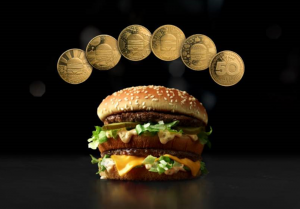
Promotional Image from McDonald’s
Although they note that the MacCoin has no cash value but can be redeemed for a Big Mac at participating restaurants, McDonald’s has entered the world of numismatics by issuing a five-coin set highlighting the 50-year history of the iconic Big Mac sandwich. Although each of the five coins has similar designs, with the 50th-anniversary logo on one side, the reverse has an image of the Big Mac in a setting highlighting a theme from each of its decades of existence:
- The ‘70s, showcasing the decade’s flower power
- The ‘80s alluding to pop art
- The ‘90s defined with bold, abstract shapes
- The early ‘00s specifically focusing on the technology that was at the forefront of the turn of the century
- The ‘10s MacCoin calling attention to the evolution of communication
According to cleveland.com, the coins were minted by Osborne Coinage Co. located in Cincinnati, Ohio.
In order to obtain a MacCoin you have to go to your local participating McDonald’s and purchase a Big Mac. You get one for each purchase while supplies last. More than 6.2 million MacCoins are available from McDonald’s restaurants in 50 countries including more than 14,000 participating restaurants in the United States.
It is not known whether you can ask for a specific coin or it is done by random selection. But here is a new opportunity for trade token collectors to include something new in your collection.
You can see a video of the commercial on YouTube.
And now the news…

July 28, 2018
COLUMBUS — Gov. John Kasich has asked the state Parole Board to hold a hearing on a clemency request for a former Toledo-area coin dealer who raised money for Ohio Republicans before being convicted in a state investment scandal that also ensnared a former governor.  → Read more at mariettatimes.com
→ Read more at mariettatimes.com

July 29, 2018
Rabat – On Throne Day, Morocco’s Bank Al Maghrib announced it will issue a new commemorative coin with a value of MAD 250. The announcement came on the 19th anniversary of King Mohammed VI’s ascension to the throne.  → Read more at moroccoworldnews.com
→ Read more at moroccoworldnews.com

July 30, 2018
Maritime archaeologists have made an astonishing discovery off the Kent coast in England. While investigating an almost three-hundred-year-old shipwreck they found some coins that had been sewn into clothing.  → Read more at ancient-origins.net
→ Read more at ancient-origins.net

July 30, 2018
"The legendary taste of the Big Mac has helped it achieve universal recognition and a lasting legacy," Susie Stames, a Cleveland-area McDonald's owner-operator, said in a statement. "Over my family's [55-year] tenure with McDonald's, Big Mac fans have enjoyed two all-beef patties, special sauce, lettuce, cheese, pickles and onions on a sesame seed bun with a flavor that's just as craveable and delicious today as it was back then."  → Read more at cleveland.com
→ Read more at cleveland.com

August 2, 2018
A California firearms instructor's search for a lucky coin missing at Anchorage's airport has left him grieving the loss. Gary Peters carried the Eisenhower dollar in his pocket every day for 34 years — ever since his daughter gave it to him when she was 5.  → Read more at adn.com
→ Read more at adn.com

August 3, 2018
An IT contractor has been jailed for stealing tens of thousands of dollars in gold bars and coins and smuggling them out of the Perth Mint, in order to fund his lavish lifestyle and "shower his partner with gifts".  → Read more at mobile.abc.net.au
→ Read more at mobile.abc.net.au
Jun 10, 2018 | coins, exonumia, news
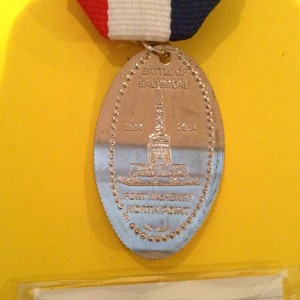
Elongated 2013 Fort McHenry quarter that was part of the Maryland Token and Medal Society souvenir card
This is where our article feature article, “Pressing Memories: Pursuing elongated coins won’t break the bank,” in Antique Trader is appropriate. It tells the story about the origin or elongated coins and the current market for these coins.
One way to consider collecting elongated coins is to collect them based on where you have been. While some people will buy postcards or lapel pins to collect as souvenirs, elongated coins can be less expensive and have even more variety than gift shop fare.
You can find the machines with the cranks that will create elongated coins in a lot of museums, theme parks, and even in on the Disney properties. Most machines charge 51-cents to $1.01 to squish and imprint a design on the one-cent coin you pay for the service. Almost all of the machines are mechanical where you do the work. They also will only elongate cents. There are a few machines that are more automated that can elongate almost any coin.
Having played around with a few of these machines, the best coin to use is one of the copper-plated zinc cents (post-1982) that is red-brown in color with more red than brown. Very shiny coins look too artificial and the design seems to get lost on brown cents. One of the reasons not to use the all-copper cents is that the rich brown that makes those cents attractive does not look as good when squished.
If you start to collect elongated coins you may consider joining The Elongated Collectors (TEC) organization. Considering that elongated coins are fun collectibles, TEC has to be a fun group. Join in and have fun!
And now the news…

June 1, 2018
By Karen Knapstein You don’t need to have an interest in coin collecting to get started in coin collecting. If you are a traveler, a fun-seeker, a keeper of mementos from family outings or historical events, creating and collecting elongated pennies may be a good fit for you.  → Read more at antiquetrader.com
→ Read more at antiquetrader.com

June 3, 2018
Before you tell me I am cuckoo, allow me to introduce Ian Watt. The 70-year-old from the United Kingdom has made the enormous amount of money in a very peculiar way. Mr Watt’s fortune has come from him never walking past a coin on the ground, with the eagle-eyed dad collecting almost a million of lost coins in his travels.  → Read more at news.com.au
→ Read more at news.com.au

June 4, 2018
Patna: The Reserve Bank of India (RBI), in view of the coin glut in Bihar, said on Monday that the central government was encouraging use of coins, and it was receiving two to four truckloads of coins daily in Patna to be distributed across the state through banks.  → Read more at telegraphindia.com
→ Read more at telegraphindia.com

June 5, 2018
(Kitco News) – The gold market continues to struggle with weak bullion demand as the Royal Canadian Mint reported a more than 50% drop in sales in the first quarter of 2018. In its first-quarter earnings report, released last week, the Canadian mint said that gold volume dropped to 108.5 thousand ounces in the first quarter, down from 228.2 thousand ounces reported in the first quarter of 2017.  → Read more at kitco.com
→ Read more at kitco.com

June 5, 2018
The Singapore Mint has released a limited-edition set of medallions to commemorate the historic first summit between a sitting U.S. president, Donald Trump, and a North Korean leader, Kim Jong Un, scheduled in the island state for June 12.  → Read more at newsweek.com
→ Read more at newsweek.com

June 8, 2018
Exploration company Golden Predator plans to start selling the coins — about $1,800 for a one-ounce coin — later this month.  → Read more at cbc.ca
→ Read more at cbc.ca

June 9, 2018
The Mint continues to tap in to its creativity and innovation to further unleash the  → Read more at globalbankingandfinance.com
→ Read more at globalbankingandfinance.com
Dec 31, 2017 | exonumia, news, tokens
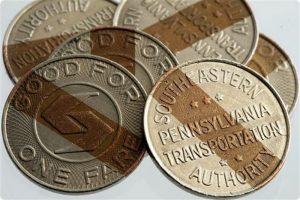 The end of the year comes with a lot of endings. This year will mark the beginning of the end for the last major metropolitan area still using transportation tokens.
The end of the year comes with a lot of endings. This year will mark the beginning of the end for the last major metropolitan area still using transportation tokens.
Just before Christmas, the Southeast Pennsylvania Transportation Authority (SEPTA), the transit agency serving the Philadelphia metropolitan region, announced that they are removing the token vending machines at El (elevated rail stations) and subway stops. The announcement said that they will continue to sell tokens at some stations and the system will continue to accept them.
SEPTA has seen a 1 million token decline in sales just in the last year as people opt to use a SEPTA Key Card and daily QuickTrip passes. It is a trend experienced nationwide. It is the result of better use of electronic payment systems and the increased cost of handling tokens. The cost of credit card swipe fees is less expensive than the physical handling of metal disks.
Farecard technology has been around for a while. I first encountered it in the early 1990s during a trip to Washington, D.C. The Washington Metro began using fare cards as a pilot in 1989 and rolled them out system-wide in 1990. My hometown of New York launched the MetroCard in 1993 and stopped using tokens in 2003.
One of the benefits of the fare cards to the transit agencies is that they can charge differing rates for different situations. Peak fares can cost more than the non-peak while using an express service can be charged an additional fare without having to carry extra tokens. The Washington Metro not only changes fares between peak and off-peak times but charges a different fare based on distance.
Be prepared Philadelphia, the days of the single fare ride for a token is almost over.
And now the news…

December 24, 2017
CAIRO, Dec. 24 (Xinhua) — Egyptian security at the Cairo International Airport has thwarted an attempt to smuggle 329 ancient coins to France, the Ministry of Antiquities said on Sunday. The coins, seized from an Egyptian passenger travelling to France, date back to the Byzantine and Ptolemy eras, the ministry said in a statement.  → Read more at xinhuanet.com
→ Read more at xinhuanet.com

December 24, 2017
The Currency Museum shows how diverse our units of commerce have been THE BANK of Japan’s Currency Museum in Tokyo exhibits mainly currencies that have been circulated in Japan, including fuhonsen coins said to be the first ever used in this country, toraisen coins imported from China during the medieval period, and oban and koban (large and small gold coins).  → Read more at nationmultimedia.com
→ Read more at nationmultimedia.com

December 26, 2017
The first ever English gold coin that had to be scrapped after a banking blunder meant is was worth less than its weight in gold, is now tipped to sell for £500,000. Some 52,000 of the King Henry III gold pennies were struck nearly 800 years ago before it was realised they were too heavy.  → Read more at dailymail.co.uk
→ Read more at dailymail.co.uk

December 26, 2017
A typewriter clacking. A droning busy signal on a landline.  → Read more at philly.com
→ Read more at philly.com

December 27, 2017
BACOLOD CITY— The Bangko Sentral ng Pilipinas (BSP) urged consumers in Negros Occidental to thoroughly check the features of the new PHP5 coins already circulating in the province. “We urge Negrenses to check the features, mainly the appearance of the coins they have, to ensure that they spend the right amount,” said Job Nepomuceno, deputy director of BSP-Bacolod.  → Read more at canadianinquirer.net
→ Read more at canadianinquirer.net

December 27, 2017
That's a lot of pocket change. We’ve all done it at some point. Yes, all of us.  → Read more at motor1.com
→ Read more at motor1.com

December 27, 2017
Coin proof set from the reign of William IV and dated 1831 which sold for £65,000 at London auction house Dix Noonan Webb on December 13-15. Three excellent 19th century examples sold in the Coins, Historical Medals and Paper Money auction held by London saleroom Dix Noonan Webb in London on December 13-15.  → Read more at antiquestradegazette.com
→ Read more at antiquestradegazette.com

December 28, 2017
What: World Coins Where: Heritage Auctions, 445 Park Ave, New York, NY 10022, USA When: 7 January, 03.50pm CT  → Read more at blouinartinfo.com
→ Read more at blouinartinfo.com

December 30, 2017
THERE are fears fake pound coins are flooding into circulation.  → Read more at dailystar.co.uk
→ Read more at dailystar.co.uk
Dec 23, 2017 | bullion, exonumia, silver
 One way to make collecting more fun is to combine interests. One of the members of my local coin club loves cats and has always had one around his house. To help enhance his collecting experience, he collects coins, medals, and tokens with images of cats.
One way to make collecting more fun is to combine interests. One of the members of my local coin club loves cats and has always had one around his house. To help enhance his collecting experience, he collects coins, medals, and tokens with images of cats.
I recently learned that the family of another club member was from Rhodesia. He is working on a collection of Rhodesian coins from before they became Zimbabwe.
Just to complete a thought, a friend’s family came to the United States and 1876 from Eastern Europe. After he traced his family’s history and their path to the United States, he collects coins that were struck in 1876 from the countries his family stopped in during their trip.
My interest is cars. I love the muscle cars of my youth, particular the Mopar muscle. But I love all of the older cars. I think that their designs through the muscle car era had depth and style. Other than the 1959 Cadillac with the biggest fins ever produced in Detroit, I find the Art Deco look of the pre-war cars very appealing.
Recently, I was able to add to my cars and numismatics collection by finding one gram silver ingots with images of vintage cars.
While searching online auctions looking for holiday-related one grams silver ingots to use as gifts, I stumbled across a seller with about two dozen of the ingots with images of classic cars including an 1879 Benz, largely considered the first commercially available automobile. I systematically placed a minimum bid on each of the ingots and decided not to pay any more than one dollar per ingot. When the auctions were over, I won 16 of the 24 that were for sale.
When they arrived, I examined them closely looking for something to indicate who might have made them. Aside from the image of the automobile on the front and the manufacturer on the reverse, there is a sequence number and a copyright that says “476” on the bottom right. The numbers are so small that I needed a 16x loupe to see them.
Each ingot contains 1 gram of .999 silver. At the current price of $16.99 per Troy ounce, each ingot contains 55-cents worth of silver. Since I paid 99-cents for each ingot I think I did pretty well on this deal. They will fit nicely with my Somalia classic cars and motorcycle coins.
If anyone has information as to who created these ingots, please comment below or contact me with the information.
 → Read more at infodocket.com
→ Read more at infodocket.com
 → Read more at collectspace.com
→ Read more at collectspace.com
 → Read more at proactiveinvestors.co.uk
→ Read more at proactiveinvestors.co.uk
 → Read more at supermanhomepage.com
→ Read more at supermanhomepage.com
 → Read more at smithsonianmag.com
→ Read more at smithsonianmag.com
 → Read more at benzinga.com
→ Read more at benzinga.com





